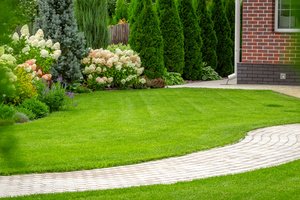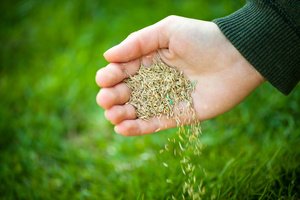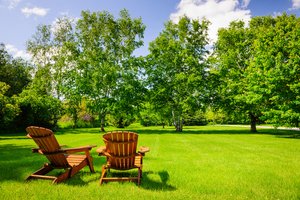Having a lush, green lawn can make your home look well cared for and increase its curb appeal dramatically. If you want to achieve a beautiful lawn, knowing the right way to plant grass seed can make all the difference. This involves getting the timing right, using the appropriate type of grass and choosing the right planting method. In many cases, it will not be necessary to mix your grass seed with topsoil, especially if you are overseeding.

Overseeding is the method of choice for homeowners who have an already existing lawn. This involves planting grass seed directly on existing turf without moving the soil. This can be a convenient way of filling in bare spots and improving the density of the turf. It is also a good method for enhancing the color of your lawn.
Overseeding is particularly popular among those who have older lawns that were established using turf grasses that are more disease or insect prone than modern varieties. By overseeding newer varieties of turf grass over an older lawn, you can improve its ability to withstand disease, traffic, drought and insects. As a result, the lawn will need less water, fertilizer and contain less pesticides. Moreover, it will look greener, healthier and thicker.
Before overseeding, however, it is important to determine the problems that have caused your original turf to deteriorate in the first place. Certain conditions that are left uncorrected could eventually compromise your overseeded lawn.
There are several problems you may encounter including poor or compacted soil, improper drainage, poor air circulation, insufficient water or sunlight, unsuitable varieties of grass for the climate, poor fertility and general neglect. A lawn professional can help you identify the problem if you are struggling. It is essential to correct any of these problems before establishing new grass.
Overseeding Methods
Here is a look at some of the most effective overseeding methods.
Broadcast Seeding

One of the most popular methods of overseeding is broadcasting seed using a cyclone or drop-style seeder. Before broadcasting grass seed, it is important to aerate the lawn several times with aeration holes that are spaced less than three inches apart. Core-type aerating tines can be used to remove soil plugs to create better seed-to-soil contact. It is important to water the area generously after overseeding to wash the seed into the aeration holes and help to break up aeration cores on the surface.
Keep in mind that seed often gets stuck in the thatch layer and doesn’t make its way into the soil where it germinates, so it is important to choose a type of grass that has a creeping growth method.
Slit Seeding
A slit seeder with verti-cutting blades can cut through the thatch layer in the existing grass to create a small slit or furrow, the depth of which will be determined by the type of grass seed you intend to plant. These units are equipped with concave disc blades that will follow into the slits and prop them open while the seeds are dropped inside to ensure that they will enter the soil and be able to germinate. This approach is typically faster than broadcast seeding and provides greater seed-to-soil contact.
Caring For Your Lawn After Overseeding
After overseeding, you can generally expect your new grass seed to emerge within about a week if the soil temperatures and moisture levels are appropriate. It will not usually take longer than eight weeks to fully establish an overseeded lawn.
However, it is essential to properly water your lawn when you are overseeding. This entails heavy watering immediately after overseeding to ensure the grass seeds make their way into the soil. During the first 10 days to two weeks until the grass seed germinates, water the lawn lightly each day to ensure that the first inch of soil is fully soaked.
Once the seeds have germinated, you can water the lawn less often, but you should make sure that the water is soaking deep enough to encourage strong root growth. Once your grass has become established, you should water it by following the recommendations for the type of grass seed you have planted.
When Should You Overseed?

Experts recommend overseeding your lawn in late summer or early fall as the temperatures are ideal for optimum germination and grass growth. As long as there is adequate sunlight, moisture, and fertilizer, grass seedlings should be well established before the cooler temperatures set in during the fall months. This time of year will also see less weed competition, which means the grass will have a better environment for growing.
When overseeding in spring, it is important to keep in mind that there is a higher chance of weather-related issues such as heavy spring rains or unexpected high temperatures-as well as weed competition. In summer, there is a higher chance of drought, heat stress, and disease. For those who must overseed at this time of year, adequate irrigation and proper weed control are essential.
Some homeowners may choose to use the dormant overseeding approach, which entails seeding in early winter or late fall after your soil temperatures have dropped low enough to stop seeds from germinating. Although this can be a challenging method to pull off effectively, it may be preferred over spring seeding in Northern areas. Successful dormant overseeding depends on the heaviness of snow cover in the winter and its ability to stop water or wind erosion from occurring while also ensuring that germination doesn’t start too early.
Do You Need to Mix Your Grass Seed With Topsoil?
Although people who are establishing a new lawn may need to mix their grass seed with topsoil prior to applying it, this is not necessary when overseeding. You should not place topsoil over grass seed as this can suffocate the seeds and stop them from sprouting-although you can add a thin layer of organic matter to promote germination.
Discuss Your Project With Dirt Connections
Ensure your lawn has the best chance of success by consulting with the professionals at Dirt Connections. We offer residential and commercial dirt grading and fill dirt delivery in the Northern Virginia area and can answer all your lawn-related questions.
Summary

Dirt Connections was started with one goal in mind: providing quality residential and commercial construction services to clients on time and on budget. Reach out for more information on how we can support your next project.
For your convenience our estimates are free and by appointment. Call 703-940-9949 for a free estimate today!









































